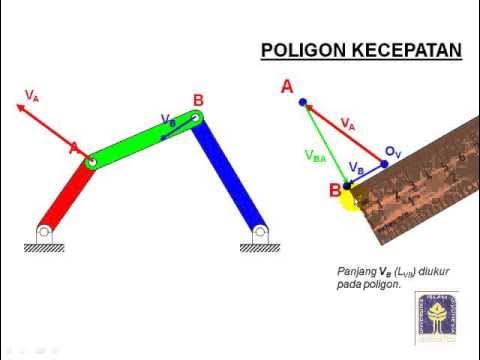pusat sesaat mekanisme yang memiliki 6 batang penghubung
Summary
TLDRThis lecture explains the process of determining instantaneous centers of velocity (ICs) for a six-link mechanical mechanism. It covers the method of identifying ICs by geometric construction, using intersection points of lines connecting the links. The process involves calculating 15 unique ICs, each related to the movement and velocity of the mechanism’s components. The lecture provides detailed steps on finding ICs for various combinations of links, demonstrating the use of diagrams and tables to map out their locations. Ultimately, these ICs are used for calculating velocities within the mechanism.
Takeaways
- 😀 The lecture focuses on determining the instantaneous centers of a mechanism with six links, continuing from previous discussions on mechanisms with four and five links.
- 😀 The process involves identifying all the connecting links (bars) in the mechanism and labeling them to facilitate the determination of the instantaneous centers.
- 😀 The number of instantaneous centers for a mechanism with six links is calculated using the formula: (n * (n - 1)) / 2, where n is the number of links. For a six-link mechanism, this gives 15 instantaneous centers.
- 😀 The first step in the process is to create a diagram representing the links and divide it into segments based on the number of connecting links.
- 😀 A table is created to help map out and identify the locations of all 15 instantaneous centers as they are discovered.
- 😀 The lecture methodically walks through the identification of each instantaneous center by analyzing different points of intersection in the mechanism, starting from known points and working towards unknown ones.
- 😀 The first known instantaneous center is at point O, where two links meet, labeled as center 12. The subsequent centers are identified by looking at intersecting lines between the connecting links.
- 😀 The analysis continues through the mechanism, including points such as A, B, C, D, and others, where the instantaneous centers are determined by finding the intersection of certain geometric lines.
- 😀 Several geometric constructions and combinations of lines are used to find each instantaneous center, with reflections and intersections playing a key role in the calculations.
- 😀 The script emphasizes that different methods and combinations of instantaneous centers can be used to determine the locations of the remaining unknown centers. It concludes with the identification of all 15 centers.
- 😀 Once all instantaneous centers are identified, the next step in the process is to calculate the velocities using these centers, which is not covered in detail in the current segment but is part of the next steps in the course.
Please replace the link and try again.
Outlines

This section is available to paid users only. Please upgrade to access this part.
Upgrade NowMindmap

This section is available to paid users only. Please upgrade to access this part.
Upgrade NowKeywords

This section is available to paid users only. Please upgrade to access this part.
Upgrade NowHighlights

This section is available to paid users only. Please upgrade to access this part.
Upgrade NowTranscripts

This section is available to paid users only. Please upgrade to access this part.
Upgrade NowBrowse More Related Video

Poligon Kecepatan UII

Kinematika: Menentukan Kecepatan pada Mekanisme 4 Batang dengan Menggunakan Metode Kecepatan Relatif

Cinemática 05: Velocidade Média, Velocidade Escalar Média, Velocidade Instantânea

SPH3U 1.04:Speed and Velocity

MACHINES in 30 Mins | Complete Chapter Mind - Map | Class 10 ICSE PHYSICS

Inversions of Single Slider crank Mechanism in Tamil #tom #kom #mechanism
5.0 / 5 (0 votes)